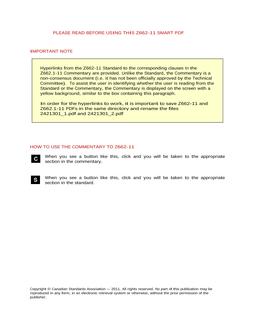CSA Z662-11 PACKAGE
Click here to purchase
Please note: The standard and the commentary are in two separate PDF files containing interactive links between the two. In order for the links to function properly, do not change the filenames, and download both files to the same directory.
This is the sixth edition of CSA Z662, Oil and gas pipeline systems. It supersedes the previous editions published in 2007, 2003, 1999, 1996, and 1994.
1.1 This Standard covers the design, construction, operation, and maintenance of oil and gas industry pipeline systems that convey (a) liquid hydrocarbons, including crude oil, multiphase fluids, condensate, liquid petroleum products, natural gas liquids, and liquefied petroleum gas; (b) oilfield water; (c) oilfield steam; (d) carbon dioxide used in oilfield enhanced recovery schemes; or (e) gas. Note: Designers are cautioned that the requirements in this Standard might not be appropriate for gases other than natural gas, manufactured gas, or synthetic natural gas.
1.2 The scope of this Standard, as shown in Figures 1.1 and 1.2, includes (a) for oil industry fluids, piping and equipment in offshore pipelines, onshore pipelines, tank farms, pump stations, pressure-regulating stations, and measuring stations; (b) oil pump stations, pipeline tank farms, and pipeline terminals; (c) pipe-type storage vessels; (d) for carbon dioxide pipeline systems, piping and equipment in onshore pipelines, pressure-regulating stations, and measuring stations; (e) for gas industry fluids, piping and equipment in offshore pipelines, onshore pipelines, compressor stations, measuring stations, and pressure-regulating stations; (f) gas compressor stations; and (g) gas storage lines and pipe-type and bottle-type gas storage vessels.
1.3 This Standard does not apply to (a) piping with metal temperatures below -70 °C; (b) piping (except oilfield steam distribution piping) with metal temperatures above 230 °C; (c) gas piping beyond the outlet of the customer’s meter set assembly (covered by CAN/CSA-B149.1); (d) piping in natural gas liquids extraction plants, gas processing plants (except main gas stream piping in dehydration and all other processing plants installed as part of gas pipeline systems), gas manufacturing plants, industrial plants, and mines; (e) oil refineries, terminals other than pipeline terminals, and marketing bulk plants; (f) abandoned piping; (g) in-plant piping for drinking, make-up, or boiler feed water; (h) casing, tubing, or pipe in oil or gas wells, wellheads, separators, production tanks, and other production facilities; (i) vent piping for waste gases of any kind operating at or near atmospheric pressure; (j) heat exchangers; (k) liquefied natural gas systems (covered by CSA Z276); (l) liquid fuel distribution systems; (m) loading/unloading facilities for tankers or barges; (n) refuelling facilities; and (o) hydrocarbon storage in underground formations and associated equipment (covered by CSA Z341 Series).
1.4 This Standard is intended to establish essential requirements and minimum standards for the design, construction, operation, and maintenance of oil and gas industry pipeline systems. This Standard is not a design handbook, and competent engineering judgment should be employed with its use. Note: For steel pipe of grade higher than Grade 555, requirements in addition to those specified in this Standard might be needed. Matters that should be considered include joining, thermal aging effects during coating application, strain capacity (including cold bending), pressure testing, assessment of imperfections, and repair.
1.5 The requirements of this Standard are applicable to the operation, maintenance, and upgrading of existing installations; however, it is not intended that such requirements be applied retroactively to existing installations insofar as design, materials, construction, and established operating pressures are concerned.
1.6 Unless otherwise stated, to determine conformance with the specified requirements, it is intended that observed or calculated values be rounded to the nearest unit in the last right-hand place of figures used in expressing the limiting value, in accordance with the rounding method of ASTM E29.
1.7 Where any requirements of this Standard are at variance with the requirements of other publications referenced in this Standard, it is intended that the requirements of this Standard govern.
1.8 It is not the intent of this Standard to prevent the development of new equipment or practices, or to prescribe how such innovations are to be handled.
1.9 In CSA standards, “shall” is used to express a requirement, i.e., a provision that the user is obliged to satisfy in order to comply with the standard; “should” is used to express a recommendation or that which is advised but not required; and “may” is used to express an option or that which is permissible within the limits of the standard. Notes accompanying clauses do not include requirements or alternative requirements; the purpose of a note accompanying a clause is to separate from the text explanatory or informative material. Notes to tables and figures are considered part of the table or figure and may be written as requirements. Annexes are designated normative (mandatory) or informative (nonmandatory) to define their application.
Click here to learn more about CSA training programs.
Product Details
- Edition:
- 6th
- Published:
- 07/01/2011
- Number of Pages:
- 731
- File Size:
- 2 files , 13 MB
- Product Code(s):
- 2421301, 2021024
